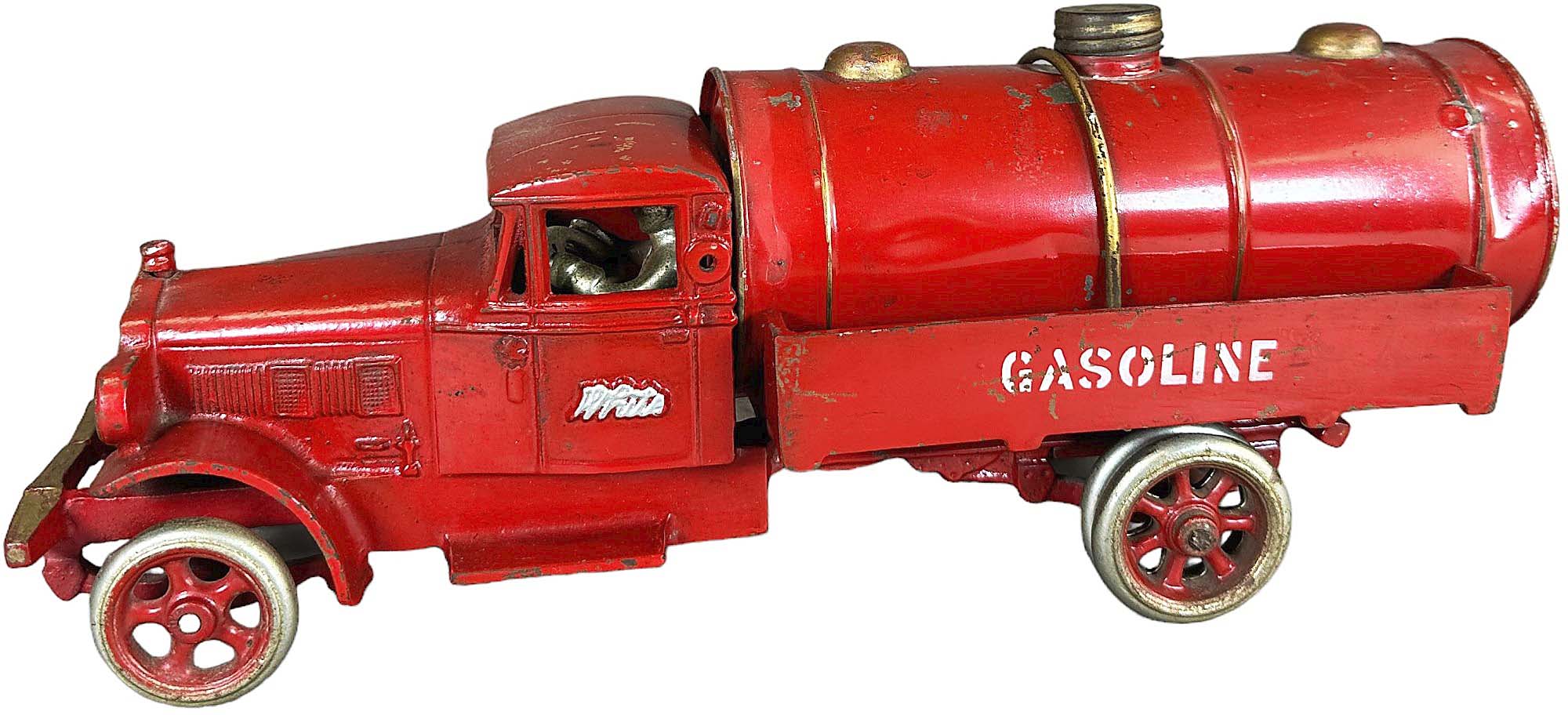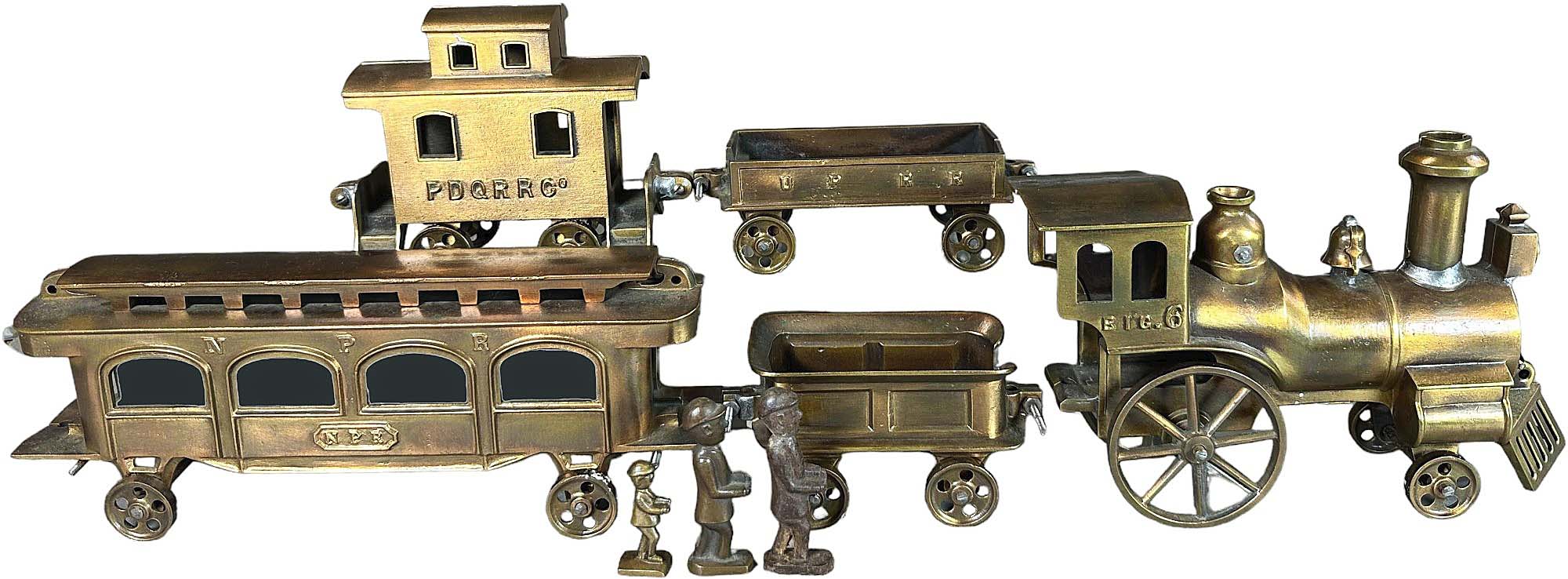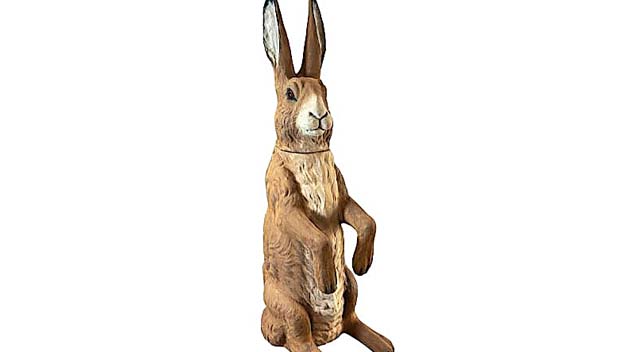#Bertoias #Spring #Auction #Disperses #TopShelf #Toy #Bank #Collections #Antiques #Arts #Weekly

This store display size rabbit candy container, 37 inches high, jumped its $2,5/4,500 estimate on the second day to land at $33,600 and was the top selling lot in the auction.
Review By W.A. Demers
VINELAND, N.J. — Bertoia’s annual spring auction, comprising approximately 1,200 diverse lots, took place April 19-20 at the firm’s gallery. Springtime vibes were ascendant as a store display sized rabbit candy container, looking more like a jackrabbit than your traditional cabbage-grazing bunny, jumped its $2,5/4,500 estimate to land at $33,600. The sale included a robust selection of spelter and cast iron mechanical banks, cast iron automotive and horse-drawn toys, a small but choice array of holiday antiques and more. Day two featured the rabbit and a large assortment of Christmas and holiday items.
More bunny-like was a French Roullet and Decamps Rabbit in Cabbage automaton. In this charming toy (charming, if you’re not a gardener), the rabbit hides inside the cabbage, peeking its head up slightly and continues to raise its head higher while chewing a piece of cabbage. Finally raising its ears, the rabbit retreats back into the cabbage. The toy surpassed its $1,2/1,800 estimate and earned $5,100.
The sale’s array of cast iron mechanical banks were highlighted by a rare National bank that surpassed its high estimate to finish at $18,000. Made by J&E Stevens Co., the building was very early and had provenance to the F.W. Weider, Bill Norman and Stan Sax collections.

An English robin on basket cart spelter bank with provenance to the Willet collection stood 4½ inches high and beat its $1/1,500 estimate, attaining $4,800.
In the spelter bank category, an English robin on basket cart spelter bank with provenance to the Willet collection also beat its $1/1,500 estimate by attaining $4,800.
An enormous Santa in a reindeer-drawn sleigh whooshed to $16,800 against its $7/10,000 estimate. The wonderful display piece evinced double clockwork German craftsmanship at its finest, its leather reins were well preserved and the figures had great expressive faces.
Santa traded in his traditional reindeer for a caribou in a lot that also brought $16,800. Cataloged as “very detailed and clean,” the piece was in pristine to near mint condition. Santa indeed appears to be fickle about his choice of rides in the minds of toy creators. Going out at $10,800 was a dual nod Santa on a polar bear, a magnificent double clockwork nodder piece, featuring a porcelain Santa head with glass eyes and impressive size at 24 inches long.
Fetching $15,600, a solitary Santa figure was in the form of a rare glass icicle-bearded belsnickel, robed in mica and standing on a mica snow mound base. Made in Germany, the large (17½ inches high) and impressive composition candy container featured a glass icicle beard and a feather tree in his folded arms.

Cast iron automotive toys were led by two Arcade trucks, each selling for $12,000, including this shovel-nose gasoline truck, a rare example of the large and heavy cast iron toy.
Cast iron automotive toys were led by two Arcade trucks, each selling for $12,000. An Arcade shovel-nose gasoline truck was a rare example of the large and heavy cast iron toy, which is seldom offered for sale, given its size (14 inches) and weight. An ultra-rare Arcade Brinks Express truck, circa 1932, was highly desirable by advanced collectors as few are known to exist. The toy was a duplicate on Donald Kaufman’s shelves decades ago, hence it became one of the few examples to be sold.
Having traveled through the Hegarty to Max Berry collections, an Althof Bergmann patriotic suffragette bell toy, circa 1874, was no worse for wear, with a clockwork mechanism propelling three figures dressed in blue and white outfits, one carrying an American flag, and featuring heart-shaped spoke wheels. It paraded across the block at $10,800.
A genuine rarity was a boxed Miner’s musical wagon, bearing an 1884 patent. A decade ago it was sold at an auction of items from the Max Berry collection and, at that time, was thought to be the only known example. Catalog notes stated that Berry had bought it directly from Louis Hertz. In 2021, another example surfaced from the Schroeder collection, depicting a man seated on top of a 17-inch-long metal chime wagon drawn by cast iron horse, emitting chimes as the toy is rolled. This example chimed at $10,800.

The 10-inch-long Wilkens racing scull pull toy, circa 1895, does not come up for sale very often. This example featured eye-catching ornate yellow star-shaped wheels, had provenance to the Max Berry Collection and found a buyer at $10,800, double its high estimate.
Among rare toys that do not come up for sale often was a 10-inch-long Wilkens racing scull pull toy. Made circa 1895, it featured eye-catching ornate yellow star-shaped wheels. It had provenance to the Max Berry collection and found a buyer at $10,800, double its high estimate.
The focus on Day One was on European and international tinplate toys. European cast iron floor trains, as well as buildings and accessories crossed the auction block, with a hand-painted German Marklin Pabst beer car, Gauge 1, 9½ inches long, recently found in a Midwest estate sale, leading the sale’s first day at $16,250.
Each fetching $12,000 were a Carlisle & Finch freight electric set, 2-inch gauge, and an example of the largest train station manufactured by Carette, circa 1907, very ornate and perfectly scaled with extensive embossed details and decorations throughout. With provenance to the Ingersoll collection, the building measured 17 inches long.
A boxed clockwork Le Train Renard, the exclusive model for “Grands Magasins du Louvre,” circa 1905, was a collector’s holy grail, a complete set with car, three trailers and original driver figure. In hand-painted tin, with a clockwork motor with drive shaft to the trailer. The catalog noted, “it is extremely difficult to find this set without any repaints or repairs”; this example exhibited a nice paint condition. It brought $10,800.

A Stevens Big 6 train set, circa 1880, assembled from the original master brass patterns, took $3,600, triple its high estimate. The set included one coach conductor, one gondola brakeman and the original carved wood pattern used to make the brass brakeman.
Back on this side of the pond, a Stevens Big 6 train set circa 1880, assembled from the original master brass patterns by the Cromwell, Conn., company, took $3,600, triple its high estimate. Catalog notes state that this is the actual set as photographed in Cast Iron Floor Trains by Rick Ralston. Included is one coach conductor, one gondola brakeman and the original carved wood pattern used to make the brass brakeman.
Kids could easily retrieve candy from a rare German Meier Father Christmas penny toy, because the figure with sled in tow pulled a basket with a removable lid for candy retrieval. Estimated $2/5,000, Father Christmas reached $9,000.
Also from Germany, a Gunthermann Vis-a-Vis tinplate toy pulled in and grabbed attention at $9,000. It had a working wind-up motor and nicely detailed lithography, while the seated driver figure was hand painted, From the French term for face-to-face, a vis-à-vis is a carriage in which the passengers sit facing the driver or other passengers.
And let us not forget doorstops, a perennial popular category at Bertoia. In this sale, a doorstop featuring a three-dimensional logo design of El Capitan Coffee, perhaps given out as a premium by the coffee company, was 8 inches high and perked up its $400/700 estimate to reach $3,300.
Prices given include the buyer’s premium as stated by the auction house. For additional information, 856-692-1881 or www.bertoiaauctions.com.




